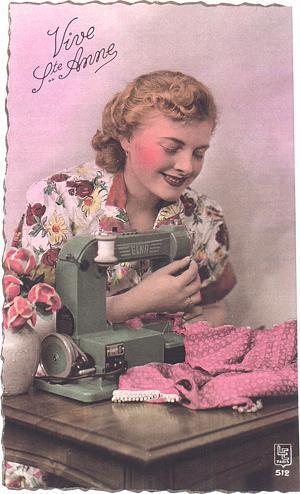
Remember the Elna:
It's time for recognition
THERE IS a brand of machine that has not received the attention it deserves from sewing-machine collectors, and that is the Elna.
One reason is that it is a product of the mid-20th Century. It wasn't even conceived of until the late 1930s
and wasn't introduced until
1943
1940.
Many collectors of sewing machines stop at 1920, which is a shame, because Elnas are distinguished by high quality and innovative design, both in appearance and in the mechanics. Otto Landgraf, in his book Oldtimer Sewing Machine, understood the early Elna's place in history and describes the innovations of the early models.
A refugee from the Spanish Civil War, Roman Casas, went to Switzerland where he teamed up with Tavaro, an armaments maker, to create an entirely new type of sewing machine.
First, it was a free-arm. Although free-arm machines had been produced in the past, they didn't market well, so most manufacturers at the time were making flat-bed machines.
Second, the Elna was die-cast aluminum. In the 1930s aluminum was finally coming down in price enough for consumer products. This made the Elna considerably lighter than other machines.

Elna's opening gambit --the highly-collectable "Grasshopper" machine
The light and the motor were integral to the machine and not add-ons. There were quite a few other mechanical innovations which were later imitated by other manufacturers. The design and colour (bright olive green) were very modern. This colour has earned it the nickname " Grasshopper " in the USA.
An interesting feature was the carrying case, which looked like an ammunition case, but unfolded to form a flat-bed table. Even the details on it were well thought out: there was a cut-out in the case that had bumpers to protect the paint on the free arm and a protective flap over this cutout. The paint on the flat bed matched the machine in colour and texture, but the paint on the rest of the case was durable crinkle texture.
The case, being of heavy sheet steel, was almost as heavy as the machine itself. The accessory box for the attachments had compartments for everything and tucked neatly into the back of the free arm for packing.

The Supermatic --launched in August 1952
We take all these types of features for granted today, but they really were innovative for their day.
In 1952 Elna came out with its Supermatic , the first automatic decorative-stitch machine of the modern era. Once again, earlier tries at machines that made decorative stitches didn't last.
Elna's try was at the right time, and soon, every manufacturer was introducing decorative stitching, either by external cams or by a dial-up internal cam system.
The Elna Supermatic was also green, but a bit more toned down than the "Grasshopper". The body style was rounded and chunky, giving a very solid feel. It, too, had a free arm and the "ammo" case like the No. l.
Some Elna Facts
The Elna One
was made from 1940 to 1952 and pioneered the modern free-arm domestic machine.
The Supermatic
was introduced in 1952 at the Swiss Industries Fair in Basle and stayed in production for 12 years.
The Star series, introduced in 1964, had a 14-year production span. It would buttonhole and had six
built-in stitch patterns.
When Elna introduced the
Lotus
in 1968 the company claimed it to be the first "compact" machine, the carrying case folding out to form a
sewing table of sorts.The wide free-arm (or narrow stitch plate)
Elnita
came along in 1976, two years before the
Air Electronic
with its combination of pneumatic and electronic features.
This machine was a fully-automatic model with single-height cams which controlled the side-to-side swing of the needle and the double-height cams, which also controlled forward-and-back-ward motion. The motor control on the Supermatic was mechanical, using a conical motor pulley on the end of the motor shaft. The bent-wire knee control was spring activated and, as the operator pushed on the control, the whole motor shaft tilted tighter and tighter onto the flywheel.
There were variations on the Supermatic through the 1960s and 1970s, with colours and appearance changing with the times. Evidently Elna was the first to introduce solid-state electronic foot controls, and in the late 1970s and into the 1980s used pneumatic speed control.
The foot control was a round rubber bellows with a tube to the body of the machine. There is a diaphragm that converts the air pressure to electrical signals for motor speed. Again, Elna used innovative but simple and reliable designs in its machines.

Elna's Star series ran 14 years from 1964
The Lotus was Elna's offering in the portable market from 1968 to the mid 1980s. It is smaller than the Singer Featherweight in size and weight, but does so much more. It has six built-in stitches, including several automatic stitches.
The quality and the fact that the Elna models marked milestones makes these machines very collectable as well as useful, and I think that 10 years or so in the future they will be very desired by collectors. Also, there were far fewer of them made than the Singers , which will add to their desirability.

The Lotus with it's fold-down cover






